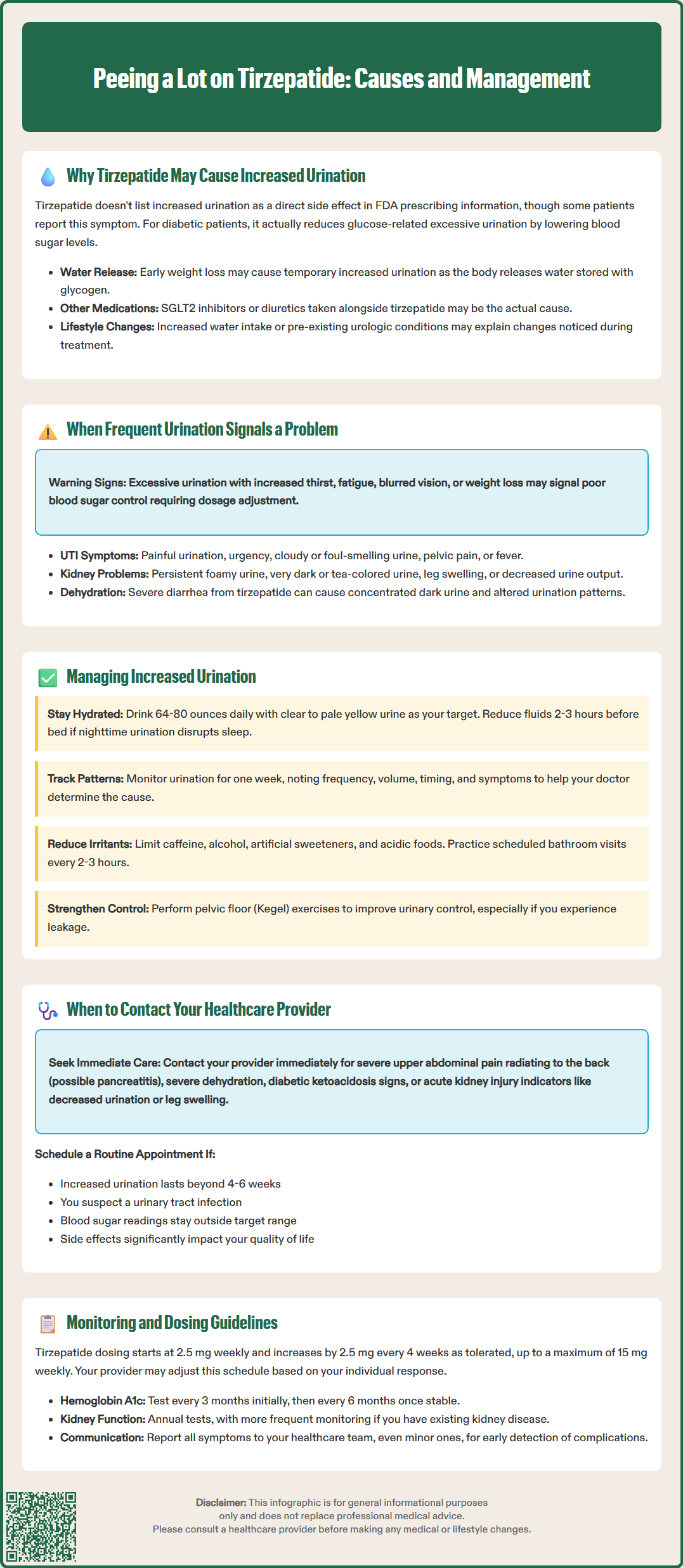LOSE WEIGHT WITH MEDICAL SUPPORT — BUILT FOR MEN
- Your personalised programme is built around medical care, not willpower.
- No generic diets. No guesswork.
- Just science-backed results and expert support.
Find out if you’re eligible

Peeing a lot on tirzepatide is a concern some patients report, though increased urination isn't listed as a direct side effect in FDA prescribing information. Tirzepatide (Mounjaro, Zepbound) is a dual GIP and GLP-1 receptor agonist approved for type 2 diabetes and chronic weight management. Several factors may explain urinary frequency changes, including improved blood sugar control, initial fluid shifts from weight loss, concurrent medications like SGLT2 inhibitors, or increased water intake. Understanding when increased urination is normal versus when it signals a problem helps patients safely benefit from this effective medication while managing potential side effects appropriately.
Quick Answer: Increased urination on tirzepatide typically results from improved blood sugar control, temporary fluid shifts during weight loss, concurrent medications, or increased water intake rather than being a direct drug side effect.
Tirzepatide (Mounjaro, Zepbound) is a dual glucose-dependent insulinotropic polypeptide (GIP) and glucagon-like peptide-1 (GLP-1) receptor agonist approved for type 2 diabetes management and chronic weight management. While increased urination is not listed as a direct adverse effect in the FDA prescribing information, several factors may explain why some patients report urinating more frequently while taking this medication.
Improved Glycemic Control
For patients with type 2 diabetes, tirzepatide significantly lowers blood glucose levels by enhancing insulin secretion and reducing glucagon release. Prior to treatment, elevated blood glucose can cause osmotic diuresis (increased urination) as excess glucose spills into the urine. As tirzepatide improves glycemic control, this glucose-induced polyuria typically decreases rather than increases.
Weight Loss and Initial Fluid Changes
Tirzepatide produces substantial weight loss—clinical trials show average reductions of approximately 15% of body weight over 72 weeks in obesity trials (SURMOUNT-1) and somewhat less in type 2 diabetes trials (SURPASS program). Early weight loss often includes reduction in glycogen stores, which release associated water that may temporarily increase urination. However, this effect is usually short-term rather than causing sustained increases in urination.
Other Common Contributors
Frequent urination while on tirzepatide may actually be related to other factors, including:
Concurrent medications, particularly SGLT2 inhibitors (which intentionally increase glucose excretion and urination) or diuretics
Changes in fluid intake patterns, especially if patients increase water consumption while making lifestyle changes
Underlying urologic conditions that may become more noticeable during treatment

While some temporary changes in urination may occur during tirzepatide treatment, certain patterns warrant clinical evaluation to rule out complications or concurrent conditions.
Signs of Hyperglycemia or Treatment Failure
Excessive urination accompanied by increased thirst (polydipsia), unexplained fatigue, blurred vision, or unintentional weight loss may indicate inadequate glycemic control. Although tirzepatide is highly effective, some patients may require dosage adjustment or additional antidiabetic medications. The American Diabetes Association recommends monitoring hemoglobin A1c every 3 months until glycemic targets are achieved, then at least twice yearly. If you notice these classic hyperglycemic symptoms, check your blood glucose if you have a home monitor and, if elevated, check for ketones according to your healthcare provider's instructions. Contact your provider promptly with these findings.
Urinary Tract Infection or Kidney Concerns
Painful urination (dysuria), urgency with small urine volumes, cloudy or foul-smelling urine, pelvic discomfort, or fever may indicate a urinary tract infection (UTI). Patients with diabetes have increased UTI risk due to glucose in urine providing a growth medium for bacteria. Additionally, if urination is accompanied by lower extremity swelling, significant changes in urine color (very dark or tea-colored), persistent foamy urine (which may suggest protein in the urine requiring testing), or decreased urine output despite fluid intake, kidney function should be evaluated.
Medication-Related Adverse Effects
Tirzepatide commonly causes gastrointestinal side effects including nausea, vomiting, and diarrhea, particularly during dose escalation. Severe or persistent diarrhea can lead to dehydration, which paradoxically may cause concentrated urine and altered urination patterns. If you experience severe gastrointestinal symptoms with signs of dehydration—dizziness, dry mouth, decreased urine output, or dark urine—seek medical attention, as fluid and electrolyte replacement may be necessary.
If increased urination is mild and not accompanied by concerning symptoms, several practical strategies can help you manage this side effect while continuing to benefit from tirzepatide therapy.
Optimize Hydration
Maintain adequate fluid intake throughout the day, aiming for clear to pale yellow urine as a hydration indicator. While approximately 8-10 cups (64-80 ounces) of water daily is a general recommendation, individual needs vary based on activity level, climate, body size, and medical conditions. If you have heart failure or kidney disease, follow your healthcare provider's specific fluid recommendations. Distribute fluid intake evenly rather than consuming large volumes at once, which can overwhelm bladder capacity. If nighttime urination (nocturia) disrupts sleep, reduce fluid intake 2-3 hours before bedtime while ensuring adequate daytime hydration.
Monitor and Document Patterns
Keep a simple log noting urination frequency, volume (subjectively: small, moderate, large), timing, and any associated symptoms for one week. This documentation helps distinguish between true polyuria (excessive urine production exceeding 3 liters daily) and urinary frequency (frequent small voids suggesting bladder irritation). Share this information with your healthcare provider to facilitate accurate assessment. If you have diabetes, correlate urination patterns with blood glucose readings to identify any relationship.
Lifestyle Modifications
Limit bladder irritants including caffeine, alcohol, artificial sweeteners, and highly acidic foods, which can increase urinary urgency and frequency. Practice timed voiding—urinating on a schedule (every 2-3 hours) rather than waiting for urgency—to maintain bladder capacity and reduce urgency episodes. Pelvic floor exercises (Kegel exercises) may strengthen urinary control, particularly if you experience any stress incontinence with coughing or physical activity.
Medication Review
Discuss all your medications with your healthcare provider, particularly if you take SGLT2 inhibitors (which increase urination by design) or diuretics. Sometimes adjusting the timing or dosage of these medications can help manage urination patterns while maintaining their therapeutic benefits.
Certain situations require prompt medical evaluation to ensure patient safety and optimize treatment outcomes.
Urgent Situations Requiring Same-Day Contact
Contact your healthcare provider immediately if you experience: severe abdominal pain (particularly upper abdominal pain radiating to the back, which may indicate pancreatitis—a rare but serious adverse effect of GLP-1 receptor agonists); signs of severe dehydration including dizziness upon standing, confusion, rapid heartbeat, or significantly decreased urine output; symptoms suggesting diabetic ketoacidosis—including excessive thirst, frequent urination, nausea, vomiting, abdominal pain, and fruity-smelling breath (requires emergency care regardless of diabetes type); or symptoms of acute kidney injury such as marked decrease in urination, swelling in legs or feet, or severe fatigue.
Situations Warranting Routine Follow-Up
Schedule an appointment within several days if: increased urination persists beyond 4-6 weeks without improvement; you develop symptoms suggesting a urinary tract infection; blood glucose readings consistently fall outside your target range; you experience intolerable side effects affecting quality of life; or you have questions about dose escalation timing. The FDA-approved dosing schedule for tirzepatide begins at 2.5 mg weekly, increasing by 2.5 mg increments every 4 weeks as tolerated, up to a maximum of 15 mg weekly for Mounjaro (diabetes) or 15 mg weekly for Zepbound (weight management). Your provider may adjust this schedule based on tolerability and response.
Routine Monitoring Recommendations
The American Diabetes Association recommends regular monitoring for patients on tirzepatide, including: hemoglobin A1c every 3 months initially, then every 6 months once stable; annual kidney function assessment (serum creatinine, estimated glomerular filtration rate, urine albumin-to-creatinine ratio)—more frequent if you have existing kidney disease; and periodic review of medication tolerability and treatment goals. Maintain open communication with your healthcare team about all symptoms, even those seeming minor, to ensure comprehensive care and early identification of any complications.
Increased urination is not listed as a direct adverse effect in FDA prescribing information for tirzepatide. When it occurs, it's typically related to improved blood sugar control, temporary fluid shifts from weight loss, concurrent medications like SGLT2 inhibitors, or increased water intake rather than the medication itself.
Contact your healthcare provider immediately if increased urination is accompanied by severe abdominal pain, signs of dehydration, symptoms of diabetic ketoacidosis, or marked decrease in urine output. Schedule a routine appointment if urination changes persist beyond 4-6 weeks or if you develop UTI symptoms.
Maintain adequate hydration with clear to pale yellow urine as your goal, distribute fluid intake evenly throughout the day, and reduce fluids 2-3 hours before bedtime if nighttime urination disrupts sleep. Keep a urination log to share with your provider and limit bladder irritants like caffeine and alcohol.
All medical content on this blog is created using reputable, evidence-based sources and is regularly reviewed for accuracy and relevance. While we strive to keep our content current with the latest research and clinical guidelines, it is intended for general informational purposes only.
This content is not a substitute for professional medical advice, diagnosis, or treatment. Always consult a licensed healthcare provider with any medical questions or concerns. Use of this information is at your own risk, and we are not liable for any outcomes resulting from its use.